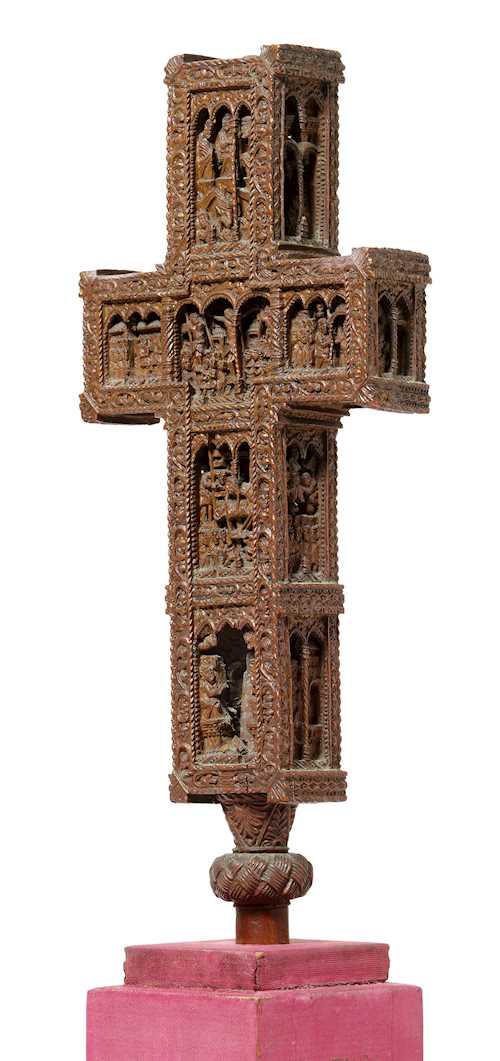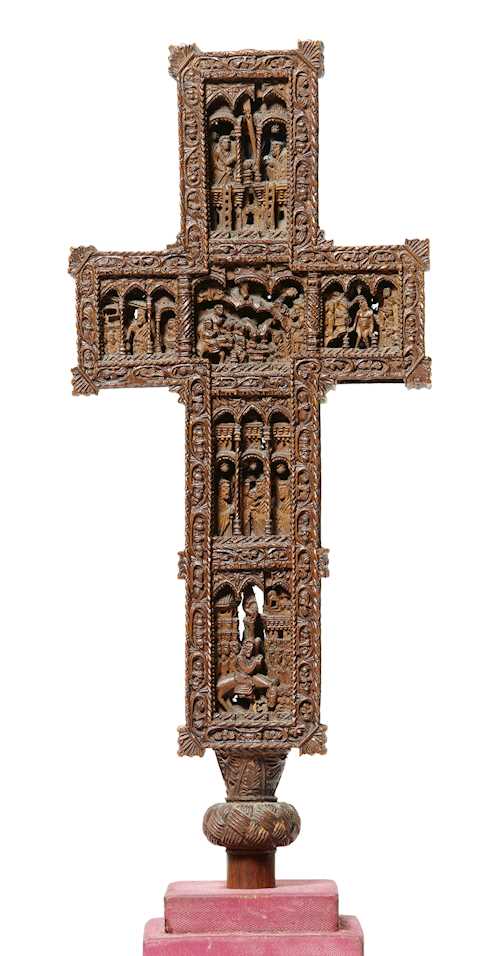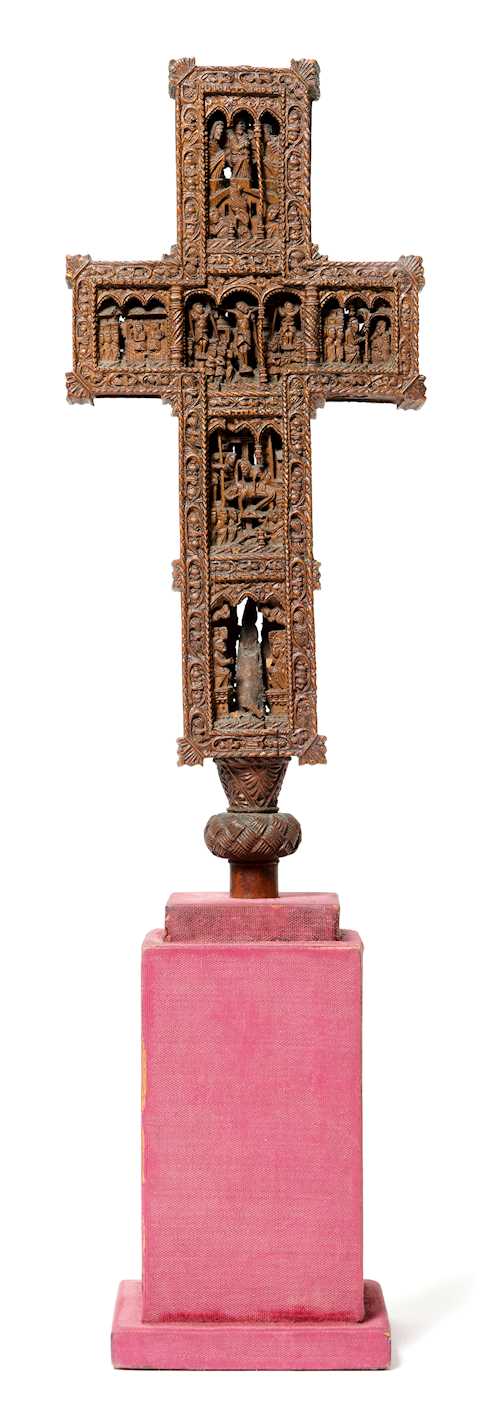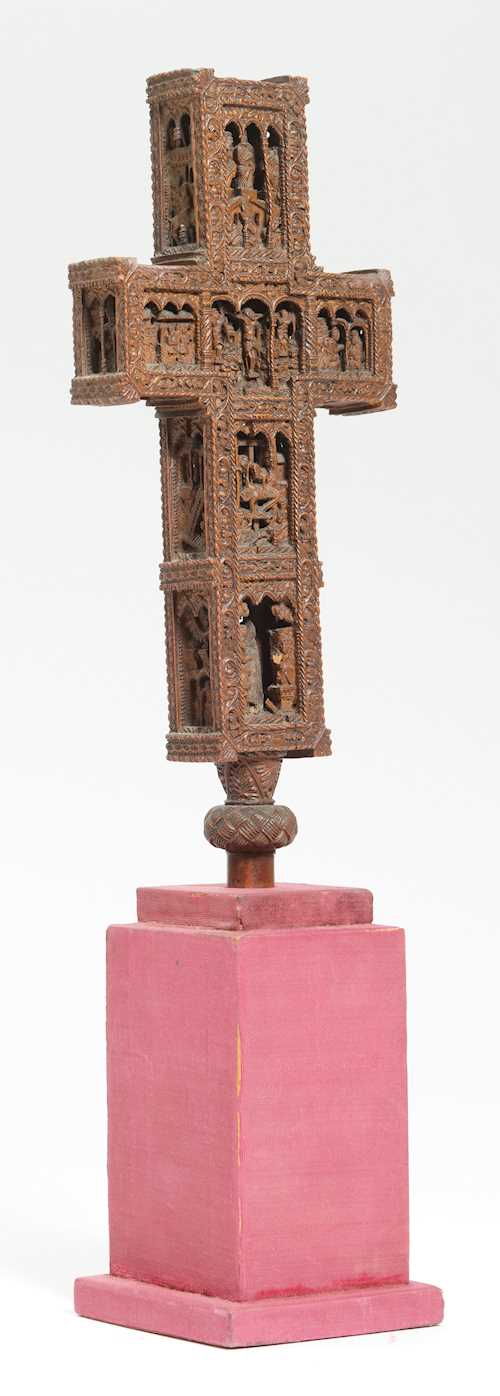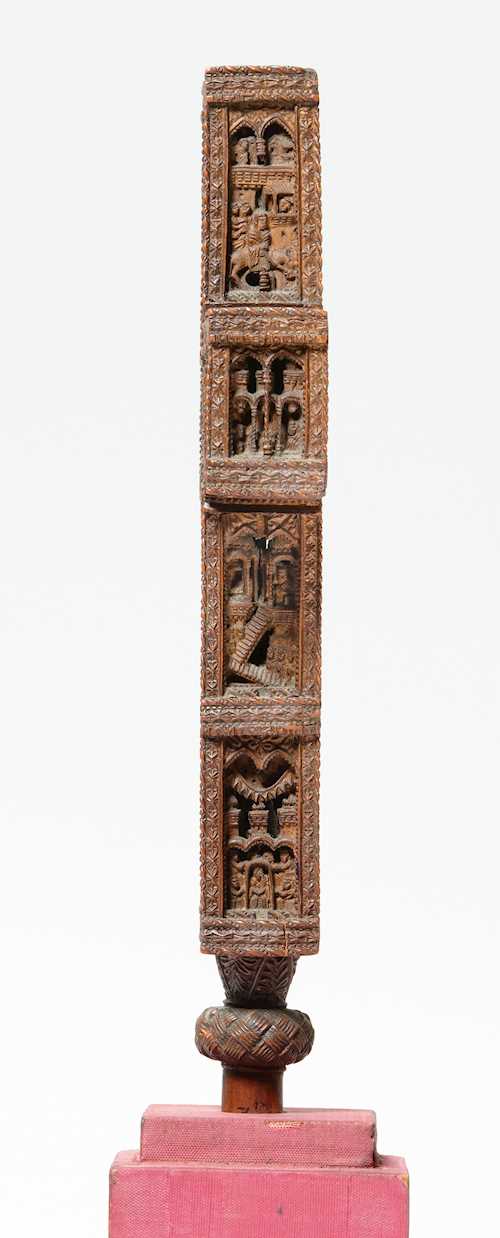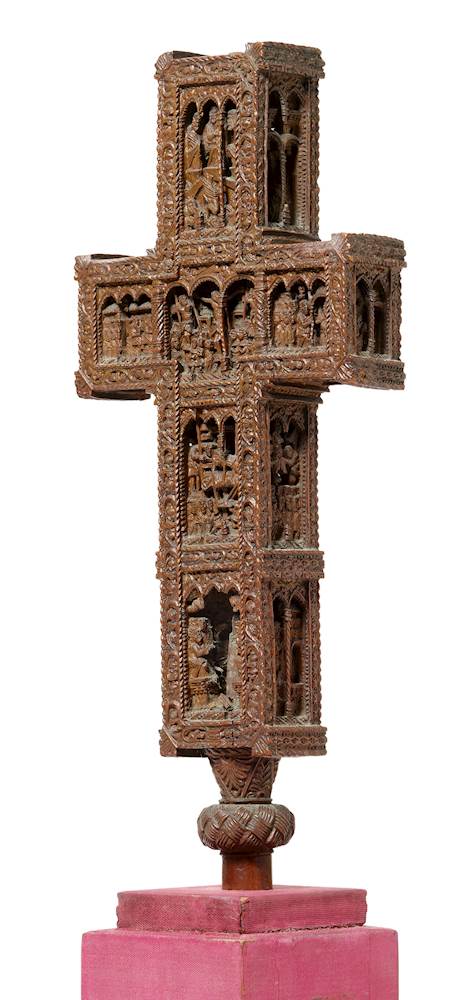
Lot 1030 - A210 Decorative Arts - Thursday, 19. September 2024, 02.00 PM
CROSS WITH MICRO-CARVING
Greek/Late Byzantine, last quarter of the 16th century Georgios Laskaris (active 1538-1583) and workshop.
Boxwood on a cylindrical shaft, intricately carved on all sides and partly pierced with scenes from the New Testament, divided into four registers, each scene with an ancient Greek title. The narrow sides worked in the same manner. On a later fabric-covered base.
H without base 23.3 cm, L 9.9 cm.
Some losses, a larger break in the lower register in the area of the shaft, minor stress cracks in the plinth area. Probably formerly on a tower-shaped base.
Provenance:
- Dutch family property.
- Through inheritance, today in a private collection in Geneva.
Although hardly any biographical information on the carver Georgios Laskaris is known to date, we know from 16 dated crosses (eight of which are also signed) that the artist, who probably came from Crete, created them between 1538-1583. Based on stylistic analogies and comparative analyses, a corpus of ca. 40-45 crosses is attributed to Georgios Laskaris and his workshop, depending on the source, which were probably produced in the second and third generation by a continuing workshop until the last third of the 17th century. The medium-sized, micro-carved crosses are typically characterized by a dome-shaped base divided into several registers, from which, per shaft, a Latin cross protrudes. The structure of these crosses usually follows a similar pattern, with the substructure often depicting Old Testament scenes, while the cross itself, which is carved on all sides and also divided into several registers, contains New Testament scenes from the life of Jesus. The religious scenes are accompanied (with a few exceptions in Latin) by Greek tituli. A linguistic analysis by Professor Myrtali Acheimastou-Potamianou suggests that, contrary to previous assumptions, Georgios Laskaris was not active on Mount Athos, but in Crete, probably in the city of Chandax (today Heraklion). Nevertheless, Laskaris' crosses are part of the late Byzantine pictorial tradition, as practiced in the monasteries of the Athos mountain region on the Greek mainland. It can be assumed that Laskaris was familiar with the artistic products of that region.
The function of such micro-carved crosses must be seen in the context of private devotion and domestic religious rites. Sheila Campbell, in her detailed study of the 'Malcove Cross' from the University of Toronto collection, which is also attributed to Laskaris, doubts that such crosses had a role in public religious ritual due to the intricate detail of the carving and the intimate size. Unlike crosses, which in the Orthodox liturgy were dipped in holy water, for example, to bless the faithful present during mass, our type of cross was designed for quiet private devotion, for example as an “aide-memoire” to commemorate the history of salvation. In contrast to the contemporaneous occidental art of the Renaissance in Europe, which focuses on emotionality, pathos and exaltation of the viewer, this late Byzantine art is much more concerned with internalizing the already familiar biblical episodes. Laskari's crosses are less concerned with depicting narrative scenes or emotional content. Instead, they are characterized by their static, non-theatrical and condensed character. The fineness of the carving and the elaboration of the details remain breathtaking, especially when one realizes that the quality of the tools available and the lighting conditions are not comparable to modern standards.
Our unpublished cross can be attributed to the oeuvre of Georgios Laskaris on the basis of the stylistic and qualitative characteristics of the carving, the iconographic relationship, the construction and the disposition of the scenes. Due to the lack of a substructure, however, no signature or dating can substantiate this attribution. Our rediscovered cross thus represents a valuable addition to the existing oeuvre from an art-historical perspective. We would like to thank Mr. lic. oec. et iur. Ueli Dubs, an expert and specialist on Georgios Laskaris, for confirming its authenticity (Zurich, June 24, 2024).
Literature:
- Victor H. Elbern: Ein Kreuz des Georgios Laskaris in den Berliner Museen, In: Jahrbuch der Berliner Museen, Berlin 2003, vol. 45, pp. 65-76.
- Myrtali Acheimastou-Potamianou: Wood carved crosses of the 16th Century by George Laskaris, In: Christian Archeological Society, Studies of Archeology and Art, Athens 2003.
- Sheila Campbell: A 16th Century Italo-Byzantine Cross, In: Gorgias Eastern Christian Studies, Piscataway, New Jersey USA 2012, vol. 32, pp. 1-50.
Cf. for similar crosses by Georgios Laskaris, his workshop or from his circle (selection):
- Staatliche Museen Berlin, Stiftung Preussischer Kulturbesitz, Skulpturensammlung und Museum für Byzantinische Kunst (inv. no. 10/68). This example is dated and signed Georgios Laskaris 1566 on the base of the tower-shaped pedestal.
- Metropolitan Museum, New York (inv. no. 2019.559a, b). That example with base.
- Victoria and Albert Museum, London (inv. no. A.2-1932 and A.3-1932 respectively). The example with base and a plaster cast of the inscription on the base of the tower-shaped pedestal, dated and signed Giorgios Lascaris, 1580.
- Swiss private collection on loan to the Museum Disentis, Graubünden, Switzerland (without inventory number). This example is dated and signed Georgios Lascaris 1569 on the base of the tower-shaped pedestal.
- Collezione Cagnola, Gazzada Varese, Italy (without inventory number). This example, dated 1583, is the last confirmed work by Georgios Laskaris. The style of this cross is more rigid and simpler in its ornamentation.
- Museo Diocesano, Feltre (without inventory number). This example is dated 1542 and has a pelican attachment.
- Probably municipal collection (?), Sant'Oreste, Rome (no inventory number). This example is dated 1546 and has a pelican attachment.
- Lillian Malcove Collection, Art Centre, University of Toronto (without inventory number). This example without inscription or date.
- Greek private collection, purchased at Koller Auctions Zurich, September 21, 2023, lot 1062, from Suisse romande private collection, Château de Courtaney à Avry, Fribourg.
- Wallace Collection, London (inv. no. S283). This copy is described as “Greek, late 16th century/early 17th century”.
Provenance:
- Dutch family property.
- Through inheritance, today in a private collection in Geneva.
Although hardly any biographical information on the carver Georgios Laskaris is known to date, we know from 16 dated crosses (eight of which are also signed) that the artist, who probably came from Crete, created them between 1538-1583. Based on stylistic analogies and comparative analyses, a corpus of ca. 40-45 crosses is attributed to Georgios Laskaris and his workshop, depending on the source, which were probably produced in the second and third generation by a continuing workshop until the last third of the 17th century. The medium-sized, micro-carved crosses are typically characterized by a dome-shaped base divided into several registers, from which, per shaft, a Latin cross protrudes. The structure of these crosses usually follows a similar pattern, with the substructure often depicting Old Testament scenes, while the cross itself, which is carved on all sides and also divided into several registers, contains New Testament scenes from the life of Jesus. The religious scenes are accompanied (with a few exceptions in Latin) by Greek tituli. A linguistic analysis by Professor Myrtali Acheimastou-Potamianou suggests that, contrary to previous assumptions, Georgios Laskaris was not active on Mount Athos, but in Crete, probably in the city of Chandax (today Heraklion). Nevertheless, Laskaris' crosses are part of the late Byzantine pictorial tradition, as practiced in the monasteries of the Athos mountain region on the Greek mainland. It can be assumed that Laskaris was familiar with the artistic products of that region.
The function of such micro-carved crosses must be seen in the context of private devotion and domestic religious rites. Sheila Campbell, in her detailed study of the 'Malcove Cross' from the University of Toronto collection, which is also attributed to Laskaris, doubts that such crosses had a role in public religious ritual due to the intricate detail of the carving and the intimate size. Unlike crosses, which in the Orthodox liturgy were dipped in holy water, for example, to bless the faithful present during mass, our type of cross was designed for quiet private devotion, for example as an “aide-memoire” to commemorate the history of salvation. In contrast to the contemporaneous occidental art of the Renaissance in Europe, which focuses on emotionality, pathos and exaltation of the viewer, this late Byzantine art is much more concerned with internalizing the already familiar biblical episodes. Laskari's crosses are less concerned with depicting narrative scenes or emotional content. Instead, they are characterized by their static, non-theatrical and condensed character. The fineness of the carving and the elaboration of the details remain breathtaking, especially when one realizes that the quality of the tools available and the lighting conditions are not comparable to modern standards.
Our unpublished cross can be attributed to the oeuvre of Georgios Laskaris on the basis of the stylistic and qualitative characteristics of the carving, the iconographic relationship, the construction and the disposition of the scenes. Due to the lack of a substructure, however, no signature or dating can substantiate this attribution. Our rediscovered cross thus represents a valuable addition to the existing oeuvre from an art-historical perspective. We would like to thank Mr. lic. oec. et iur. Ueli Dubs, an expert and specialist on Georgios Laskaris, for confirming its authenticity (Zurich, June 24, 2024).
Literature:
- Victor H. Elbern: Ein Kreuz des Georgios Laskaris in den Berliner Museen, In: Jahrbuch der Berliner Museen, Berlin 2003, vol. 45, pp. 65-76.
- Myrtali Acheimastou-Potamianou: Wood carved crosses of the 16th Century by George Laskaris, In: Christian Archeological Society, Studies of Archeology and Art, Athens 2003.
- Sheila Campbell: A 16th Century Italo-Byzantine Cross, In: Gorgias Eastern Christian Studies, Piscataway, New Jersey USA 2012, vol. 32, pp. 1-50.
Cf. for similar crosses by Georgios Laskaris, his workshop or from his circle (selection):
- Staatliche Museen Berlin, Stiftung Preussischer Kulturbesitz, Skulpturensammlung und Museum für Byzantinische Kunst (inv. no. 10/68). This example is dated and signed Georgios Laskaris 1566 on the base of the tower-shaped pedestal.
- Metropolitan Museum, New York (inv. no. 2019.559a, b). That example with base.
- Victoria and Albert Museum, London (inv. no. A.2-1932 and A.3-1932 respectively). The example with base and a plaster cast of the inscription on the base of the tower-shaped pedestal, dated and signed Giorgios Lascaris, 1580.
- Swiss private collection on loan to the Museum Disentis, Graubünden, Switzerland (without inventory number). This example is dated and signed Georgios Lascaris 1569 on the base of the tower-shaped pedestal.
- Collezione Cagnola, Gazzada Varese, Italy (without inventory number). This example, dated 1583, is the last confirmed work by Georgios Laskaris. The style of this cross is more rigid and simpler in its ornamentation.
- Museo Diocesano, Feltre (without inventory number). This example is dated 1542 and has a pelican attachment.
- Probably municipal collection (?), Sant'Oreste, Rome (no inventory number). This example is dated 1546 and has a pelican attachment.
- Lillian Malcove Collection, Art Centre, University of Toronto (without inventory number). This example without inscription or date.
- Greek private collection, purchased at Koller Auctions Zurich, September 21, 2023, lot 1062, from Suisse romande private collection, Château de Courtaney à Avry, Fribourg.
- Wallace Collection, London (inv. no. S283). This copy is described as “Greek, late 16th century/early 17th century”.
CHF 20 000 / 30 000 | (€ 20 620 / 30 930)

